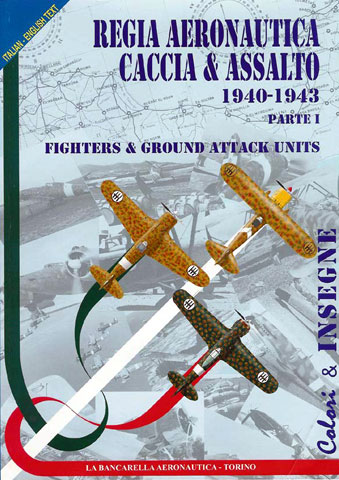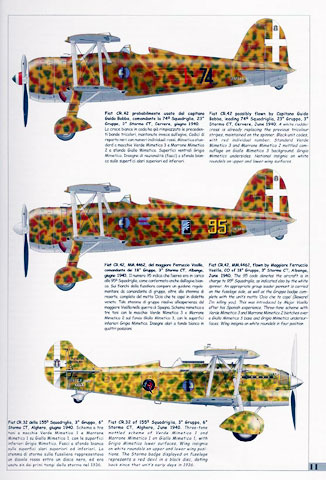|
 Regia
Aeronautica Regia
Aeronautica
Caccia & Assalto
1940-1943
Parte I
by Paolo Waldis & Marino De Bortoli
Artwork by Angelo Brioschi
La Bancarella Aeronautica - Torino
|
S
u m m a r y
|
| Publisher and Catalogue
Details: |
Regia Aeonautica Caccia & Assalto
1940-1941 Part I by Paolo Waldis & Marino De Bortoli; Artwork by Angelo
Brioschi. Published by La Bancarella Aeronautica - Torino |
| ISBN: |
|
| Media and Contents: |
80 pages of text. B&W photos,
approx. 92 profiles (10 of which are three view), illustrated page of RA
fighter and assault unit emblems, and RA fighter unit structure. |
| Price: |
23 Euros |
| Review Type: |
FirstRead |
| Advantages: |
Italian and English text, well
written and well illustrated. |
| Disadvantages: |
|
| Recommendation: |
Highly Recommended, especially to
Regia Aeronautica enthusiasts. |
Reviewed by Steven "Modeldad" Eisenman

HyperScale is proudly supported by Squadron.com
As many of you know, I enjoy delving into the minor air forces and
aircraft of the Second World War, including the Reagia Aeronautica. For
those of you who share my enjoyment, this book will be a welcome addition
to your reference library. It is written in Italian and English (parallel
columns and dual captions), and the English translation is quite well
done.
In English, the full title is “Camouflage and Markings of the Regia
Aeronatica Fighter and Ground Attack Units 1940 – 1943 Part One” and this
book delivers on that title. The book opens with a short overview of RA
camouflage styles and colors and national markings during this period. Not
to give away the punch line right away, but we learn that a single
aircraft could have as many as 18 fasces on it! We also learn that prior
to 1941 there was no organized systems of colors and camouflage
application. Color and style of camouflage depended primarily on which
paint company supplied the paint to which manufacturer.
 The
authors then proceed to discuss the development (or lack there of) of
camouflage and markings in different theatres of war beginning with the
War on France. They continue with the Channel Front, Malta and the
Mediterranean, Greece, North Africa and conclude with East Africa. The
authors then proceed to discuss the development (or lack there of) of
camouflage and markings in different theatres of war beginning with the
War on France. They continue with the Channel Front, Malta and the
Mediterranean, Greece, North Africa and conclude with East Africa.
We learn that the white fuselage band was not so much an identification of
aircraft assigned to a theater of operation, but rather a way to prevent
RA aircraft from being shot down by German aircraft. A Fiat Cr. 42 was
often mistaken for a Gladiator!
Finally, the authors conclude with a discussion of the colors used during
the period. They make a good attempt to correlate the colors to an FS
approximation and to Humbrol paints.
The book is full of well illustrated profiles. In my opinion, they are
some of the best color representations of RA camouflage that have been
printed. The aircraft represented are primarily the Fiat Cr. 32, 42 and
G50, which formed the core of the RA during this period.
In conclusion, for those who enjoy researching and modeling the RA, and
who do not read Italian, this book is as important as Paul Lucas’s
Camouflage and Markings: the Battle for Britain is to those who model the
RAF. I recommend this book highly. I also want to drag out that old
Classic Airframes Cr.42 so I can do it with the green, white and red
rudder stripes!
Highly Recommended.
Thanks to IBN for the review sample
Review Copyright © 2003 by
Steven Eisenman
Page Created 22 October, 2003
Last updated 21 October, 2003
Back to HyperScale
Main Page
Back to Reviews
Page
|
|
Home | What's
New | Features
| Gallery |
Reviews | Reference
| Forum
| Search